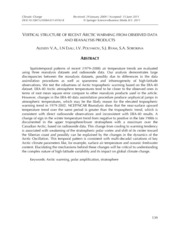| dc.contributor.author | Alexeev, V. A. | eng |
| dc.contributor.author | Esau, Igor N. | eng |
| dc.contributor.author | Polyakov, Igor V. | eng |
| dc.contributor.author | Byam, S. J. | eng |
| dc.contributor.author | Sorokina, Svetlana | eng |
| dc.date.accessioned | 2014-09-12T12:50:27Z | |
| dc.date.available | 2014-09-12T12:50:27Z | |
| dc.date.issued | 2012-03 | eng |
| dc.identifier.issn | 0165-0009 | en_US |
| dc.identifier.uri | https://hdl.handle.net/1956/8463 | |
| dc.description | The final publication is available at Springer via http://dx.doi.org/10.1007/s10584-011-0192-8 | en_US |
| dc.description.abstract | Spatiotemporal patterns of recent (1979–2008) air temperature trends are evaluated using three reanalysis datasets and radiosonde data. Our analysis demonstrates large discrepancies between the reanalysis datasets, possibly due to differences in the data assimilation procedures as well as sparseness and inhomogeneity of high-latitude observations. We test the robustness of Arctic tropospheric warming based on the ERA-40 dataset. ERA-40 Arctic atmosphere temperatures tend to be closer to the observed ones in terms of root mean square error compare to other reanalysis products used in the article. However, changes in the ERA-40 data assimilation procedure produce unphysical jumps in atmospheric temperatures, which may be the likely reason for the elevated tropospheric warming trend in 1979-2002. NCEP/NCAR Reanalysis show that the near-surface upward temperature trend over the same period is greater than the tropospheric trend, which is consistent with direct radiosonde observations and inconsistent with ERA-40 results. A change of sign in the winter temperature trend from negative to positive in the late 1980s is documented in the upper troposphere/lower stratosphere with a maximum over the Canadian Arctic, based on radiosonde data. This change from cooling to warming tendency is associated with weakening of the stratospheric polar vortex and shift of its center toward the Siberian coast and possibly can be explained by the changes in the dynamics of the Arctic Oscillation. This temporal pattern is consistent with multi-decadal variations of key Arctic climate parameters like, for example, surface air temperature and oceanic freshwater content. Elucidating the mechanisms behind these changes will be critical to understanding the complex nature of high-latitude variability and its impact on global climate change. | en_US |
| dc.language.iso | eng | eng |
| dc.publisher | Springer | en_US |
| dc.relation.ispartof | <a href="http://hdl.handle.net/1956/8428" target="blank">Certain aspects of high latitude climate variability</a> | en_US |
| dc.subject | Arctic warming | eng |
| dc.subject | Polar amplification | eng |
| dc.subject | Stratosphere | eng |
| dc.title | Vertical structure of recent arctic warming from observed data and reanalysis products | en_US |
| dc.type | Peer reviewed | |
| dc.type | Journal article | |
| dc.description.version | acceptedVersion | en_US |
| dc.rights.holder | Copyright Springer Science+Business Media B.V. 2011 | en_US |
| dc.identifier.doi | https://doi.org/10.1007/s10584-011-0192-8 | |
| dc.identifier.cristin | 835271 | |
| dc.source.journal | Climatic Change | |
| dc.source.40 | 111 | |
| dc.source.14 | 2 | |
| dc.source.pagenumber | 215-239 | |
